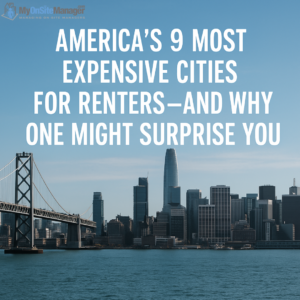If you thought rent prices were cooling down — think again. A recent ranking of the most expensive U.S. cities for renters shows that affordability continues to be a major challenge across major urban centers, with some surprising shifts in the list.
From iconic coastal hubs to fast-growing desert cities, these places command sky-high prices due to a mix of limited housing supply, strong local economies, and demographic shifts. Here’s a detailed look at the top nine most expensive cities for renters right now — and what’s driving the costs.
1. New York, NY
New York holds the undisputed crown for the highest rents in the nation. In Manhattan, average one-bedroom apartments easily surpass $4,000 per month, with luxury high-rises charging far more. The city’s unique combination of global financial power, cultural influence, and historical housing constraints (hello, rent control battles) means demand always outstrips supply. Despite a brief pandemic-era dip, rents have bounced back with a vengeance as workers return to offices and tourism revives.
2. San Francisco, CA
Even after the tech layoffs of the past year, San Francisco continues to boast some of the most expensive rents in the country. With average rents sitting near $3,800, the city’s limited geography — squeezed between the Pacific and the Bay — and strict building regulations keep housing scarce. Tech workers, startups, and investors still flood the area, ensuring competition stays fierce.
3. San Jose, CA
At the heart of Silicon Valley, San Jose is often overshadowed by its flashier neighbors, but it’s no bargain. Home to many tech giants’ campuses, San Jose has seen average rents climb past $3,500. With affluent tech workers vying for limited housing, even modest apartments come at a premium, and families often compete for suburban-style rentals that command top dollar.
4. Boston, MA
Boston combines historical charm, world-renowned universities, and cutting-edge biotech firms — a recipe for relentless housing demand. With average monthly rents topping $3,300, students, young professionals, and researchers compete for apartments across Cambridge, Back Bay, and South Boston. Housing supply has struggled to keep pace, pushing up costs citywide.
5. San Diego, CA
San Diego offers the allure of year-round sunshine, pristine beaches, and a thriving military and biotech scene — but at an average rent of $3,200, it’s hardly a budget-friendly paradise. High demand, limited coastal development, and a steady flow of new residents from pricier markets like Los Angeles and San Francisco keep the rental market tight.
6. Los Angeles, CA
L.A.’s sprawling metropolis stretches across glitzy enclaves like Beverly Hills and Santa Monica to artsy neighborhoods like Silver Lake. Regardless of where you look, rents hover around $3,100. With major entertainment, tech, and media industries converging, the city’s appeal continues to attract renters — even as many residents grapple with stagnant wages and soaring housing costs.
7. Washington, D.C.
As the nation’s capital, D.C. draws thousands of government workers, lobbyists, lawyers, and international professionals. With rents averaging around $3,000, the city’s political and economic clout ensures a steady stream of newcomers, especially in sought-after areas like Dupont Circle, Georgetown, and Capitol Hill.
8. Scottsdale, AZ — The Surprise Entry
Perhaps the biggest eyebrow-raiser on the list is Scottsdale. Once known as a laid-back desert getaway, the city has transformed into a luxury hotspot, drawing retirees, remote workers, and affluent newcomers. With upscale developments, golf resorts, and luxury condos multiplying, Scottsdale’s average rent now sits near $2,700 — outranking more familiar rental hubs like Chicago and Miami. The city’s rising profile reflects broader trends: remote work is shifting demand into once-overlooked (and once-affordable) markets.
9. Seattle, WA
Seattle has long been a darling of the tech boom, home to Amazon, Microsoft, and countless startups. With rents averaging over $2,700, the city’s ongoing tech-driven growth, combined with geographic constraints and zoning limitations, keeps housing demand sky-high. Neighborhoods like Capitol Hill, South Lake Union, and Ballard are particularly popular — and expensive.
What’s Driving These High Rents?
Several key forces are at play:
Limited housing supply. Many of these cities have strict zoning, geographic barriers, or sluggish construction rates that limit new housing stock.
Strong job markets. Cities with booming industries — tech, finance, biotech, government — attract well-paid workers willing to pay top dollar.
Post-pandemic rebounds. Urban centers that saw people leave during the pandemic are now regaining residents, pushing rents back up.
Demographic shifts. Remote work and lifestyle changes have driven demand into surprising new markets, like Scottsdale, raising prices there.
What Can Renters Do?
Expand your search radius. Look into nearby suburbs or smaller cities where rents may be lower but access to jobs and amenities remains strong.
Consider co-living or shared housing. Splitting rent with roommates can significantly cut costs in high-rent markets.
Stay informed on local policies. Watch for new housing initiatives, rent control measures, or affordable housing projects in your area.
Negotiate where possible. In slower-moving markets or during the off-season, landlords may be open to offers below the listed rent.
Final Thoughts
While it’s no surprise that cities like New York and San Francisco continue to dominate the list of most expensive rental markets, it’s the rise of places like Scottsdale that signals a shifting rental landscape in the U.S. As remote work and demographic trends reshape housing demand, renters need to stay alert, flexible, and informed to navigate today’s challenging market.
For the full list and original report, visit the MSN article here.

